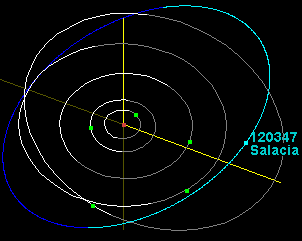Discovery date 22 September 2004 Observation arc 10330 days (28.28 yr) Discovered 22 September 2004 Argument of perihelion 307.9° | MPC designation (120347) 2004 SB60 Orbital period 271 years Inclination 23.936° Discoverer Michael E. Brown | |
 | ||
Discovered by Henry G. Roe, Michael E. Brown, Kristina M. Barkume Pronunciation /sæˈleɪʃiə/ (sal-AY-shee-ə) or/səˈleɪʃə/ (sə-LAY-shə) Minor planet category Cubewano (MPC)Extended (DES) Similar Michael E Brown discoveries, Other celestial objects | ||
120347 Salacia is a large planetoid in the Kuiper belt. It was discovered on 22 September 2004 by Henry G. Roe, Michael E. Brown and Kristina M. Barkume at the Palomar Observatory. It is almost certainly a dwarf planet. Salacia's diameter is estimated to be about 850 kilometres (530 mi) due to a low albedo. It has been observed 100 times, with precovery images back to 1982. Salacia orbits the Sun at an average distance that is slightly larger than that of Pluto. It has a single known moon, Actaea.
Contents
Discovery
Salacia was discovered on 22 September 2004 by Henry G. Roe, Michael E. Brown, and Kristina M. Barkume at the Palomar Observatory and assigned the provisional designation (120347) 2004 SB60.
Name
It was named Salacia /sæˈleɪʃə/ on 18 February 2011, after Salacia, the goddess of salt water and the wife of Neptune.
The moon's name, Actaea /ækˈtiːə/, was assigned on the same date. Actaea is a nereid or sea nymph.
Orbit
Salacia is a non-resonant object with a moderate eccentricity (0.107) and large inclination (23.9°), making it a scattered–extended object in the classification of the Deep Ecliptic Survey and a hot classical in the classification system of Gladman et al., which may be a non-distinction if they are part of a single population that formed during the outward migration of Neptune. Salacia's orbit is within the parameter space of the Haumea collisional family, but Salacia is not part of it, because it lacks the strong water-ice absorption bands typical of its members.
Physical characteristics
The total mass of the Salacia–Actaea system is 7020438000000000000♠(4.38±0.16)×1020 kg, of which some 96% should be in Salacia itself, from the relative diameters. Salacia is large enough that it is unlikely to have a significant porosity and is likely differentiated. A rocky core (with a density 2.77–3.66 g/cm3) can be 0.4–0.65 of the total diameter of Salacia if its water-ice mantle is non-porous, and 0.45–0.7 of its total diameter if its mantle has 10% porosity.
Salacia has the lowest albedo and density known of any known big trans-Neptunian object. Salacia's infrared spectrum is almost featureless, indicating an abundance of water ice of less than 5% on the surface. Its light-curve amplitude is only 3%.
Mike Brown's website lists Salacia as nearly certainly a dwarf planet, but the IAU has not formally recognized it as such.
Satellite
Salacia has one natural satellite, Actaea, that orbits its primary every 7005474664320000000♠5.49380±0.00016 d at a distance of 7006561900000000000♠5619±89 km and with an eccentricity of 6997840000000000000♠0.0084±0.0076. It was discovered on 21 July 2006 by Keith S. Noll, Harold Levison, Denise Stephens and Will Grundy with the Hubble Space Telescope.
Actaea is 7000237200000000000♠2.372±0.060 magnitudes fainter than Salacia, implying a diameter ratio of 2.98 for equal albedos. Hence, assuming equal albedos, it has a diameter of 7005286000000000000♠286±24 km Actaea has the same color as Salacia (V−I = 6999890000000000000♠0.89±0.02 and 6999870000000000000♠0.87±0.01, respectively), supporting the assumption of equal albedos.
It has been calculated that the Salacia system should have undergone enough tidal evolution to circularize their orbits, which is consistent with the low measured eccentricity, but that the primary need not have been tidally locked. The ratio of its semi-major axis to its primary's Hill radius is 0.0023, the tightest trans-Neptunian binary with a known orbit. Salacia and Actaea will next occult each other in 2067.
